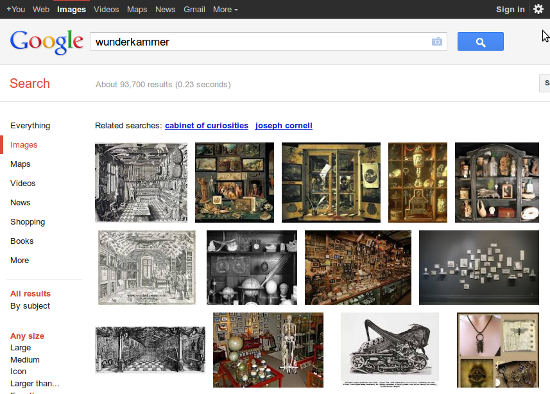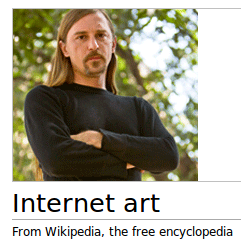User:Sebastians: Difference between revisions
Sebastians (talk | contribs) No edit summary |
Sebastians (talk | contribs) No edit summary |
||
| Line 49: | Line 49: | ||
{{#ev:youtube|2YL41fGxzvY|500}} | |||
Justin.tv | Justin.tv | ||
Revision as of 21:31, 27 November 2011
Father Christmas
 Wiki War will be back
Wiki War will be back
Performing a search on Google is a bit like looking at a Wunderkammer (cabinet of curiosities). Of course, this comparison is not really apt as the search results mostly aren't curiosities (in fact, they should be way more often!). However, the search results page is an assemblage of things found in a space, that has expanded to such a degree, that we can't make any sense of it anymore without the help of search engines (which, however, aren't and shouldn't be the only solution to this problem). This space is in fact our externalized collective memory.
By crawling the web, and by analyzing, categorizing, and storing what they find along the way, search engines try to create a paradigm (in the linguistic meaning: a collection of signs) out of which answers to our questions can be constructed. The construction of meaning depends a) on the existence and availability of elements (what we put on the web, and what then gets indexed by the search engine) and b) on the rules applied in order to construct the answer.
It is obvious how the construction of meaning, the formation of knowledge, is shaped by algorithms (rules). However, these algorithms are far from being transparent. In fact they are well kept secrets, often being regarded as a myth. In this sense, the comparison to the Wunderkammer starts to regain some meaning, as Wunder in German not only means curiosity, but also miracle.
It is not only knowledge that equals power, but also the way how knowledge is being shaped. Therefore, algorithms that are not transparent establish and maintain a hierarchy of power.
Google's Search by Image
The decoding of visual signs has long remained a domain of the human being. However, as technology learns to “see”, to decipher visual signs, images become searchable information, too. What really fascinates me at the moment is Google's Search by Image, a feature that allows the user to submit images as “questions”.
How does Google make sense of this immense pile of images, by looking “at” the image, and not at the textual context only? How does the algorithm work, if at all? Is this a useful tool to gain insights into our collective visual memory? Or is it simply a tool empowering media companies and their lawyers, as the search feature makes it in fact very easy to find “illegal” copies of a an image?
Another attempt at creating a database of all things relevant to know is Wikipedia. Instead of relying on algorithms, it is a collaborative effort of people trying to decide what is important enough to be part of the encyclopedia, and then how it best be described.
The entry for http://en.wikipedia.org/wiki/Internet_art is an attempt to textually describe an art form that deals with the Internet, including Wikipedia, as its material.
Through the use of CSS, it is possible to completely replace (overlay) an entry within Wikipedia (as has been proven in the Wiki War). My proposal is to overlay the entry for Internet Art with a "piece of Internet Art" (or a failed attempt), as an experiment to replace the textual description with an example of what it describes. Of course, this version won't last long. The hope is however for it to remain in the entry's history (or will sth. like this be completely deleted?).
{{#ev:youtube|2YL41fGxzvY|500}}
Justin.tv


